Most households have a typical Coat Closet, featuring a short rod, a single upper shelf, some floor space, and a standard door.
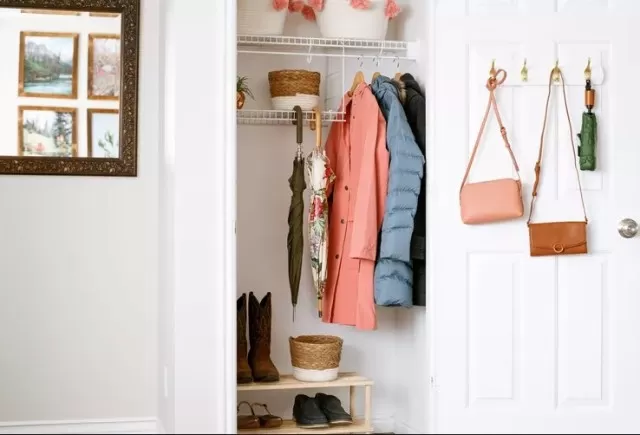
Unfortunately, due to its hidden nature, the coat closet often becomes a repository for clutter.
However, there’s no need to dread opening the door. We are here to provide you with our top tips for organizing your coat closet, ensuring that you can quickly locate what you need when you’re in a hurry.
Whether it’s a coat, an umbrella, or your favorite pair of sneakers, everything in your closet should be visible and easily accessible during busy mornings.
Follow our step-by-step guide to achieve a straightforward and efficient coat closet organization system, allowing you to save time and alleviate stress.
Declutter Your Coat Closet
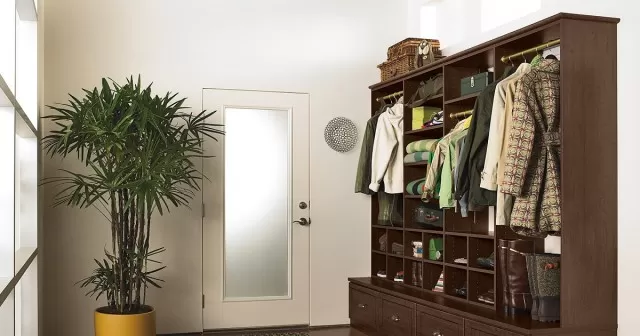
Before embarking on any home organizing project, it’s essential to empty out the space and sort through its contents.
This step is crucial to avoid wasting time finding space for items that are no longer needed, wanted, or belong elsewhere, as is often the case with coat closets. Set aside a few hours on a weekend and ensure that all household members whose belongings are in the closet are present to make decisions as well.
Start by creating separate piles for different categories.
Group all outerwear together in one section, using a nearby couch or armchair to neatly lay them down. Place footwear in another section and accessories in a different pile.
You can further categorize items by family member or season. For example, gather winter hats, scarves, and gloves in one group, and summer hats, bags, and sunglasses in another.
If your coat closet also stores purses, backpacks, or pet supplies, set those items aside as well.
As you sort through the items, pay attention to what can be decluttered.
Donate coats that no longer fit or match your style. If you have children, pack away jackets that are in-between sizes (but still in good condition) and label them for future use as hand-me-downs.
Apply the same approach to shoes, hats, and winter gear. Any items that don’t belong in the coat closet should be returned to their proper places in the house.
While the closet is empty, take the opportunity to thoroughly clean it.
Vacuum the floor and wipe away any dust. Remove scuff marks from the walls or, if you’re feeling ambitious, give them a fresh coat of paint.
Create Zones in a Coat Closet
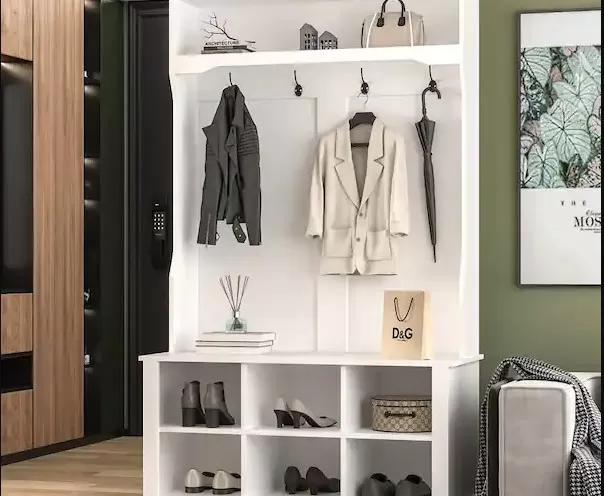
Once you’re left with only the items you want to keep in the coat closet, it’s time to establish separate zones for each category.
Remember, organizing similar items together is one of the best ways to maintain an organized space. While every home, closet, and personal preference may differ, consider the following as a starting point for basic coat closet sections:
Outerwear: Coats, jackets, vests, and cardigans.
Shoes: Everyday sneakers, sandals, and boots.
Accessories: Hats, gloves, scarves, and other accessories.
Daily essentials: Items needed when leaving the house, such as bags, umbrellas, sunglasses, and a lint roller.
Pet supplies: Leashes, travel water bottles, bags, and pet apparel.
How to Organize Coats
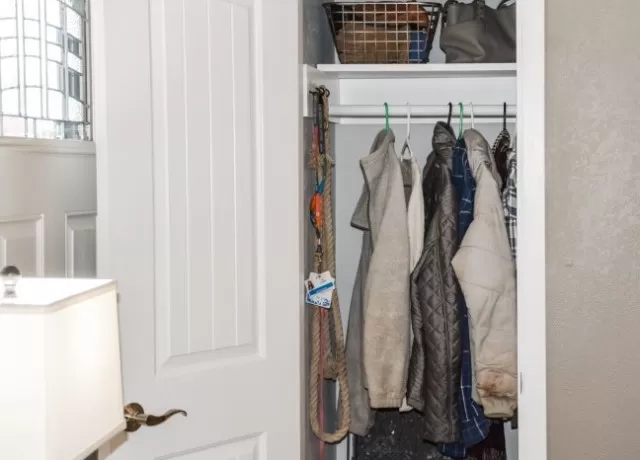
Since the primary function of the closet is to store coats, begin organizing in this category.
Here are several ways to organize coats, so choose the method that works best for you:.
Organize outerwear by type:
Separate heavy down coats from lighter spring or fall jackets and vests.
During warmer months, keep winter coats to one side of the closet and swap them when the weather gets cold. If you’re struggling with limited space, consider storing off-season coats elsewhere.
Remember to wash the coats before storing them for the season.
Organize outerwear by household members:
Use closet divider labels to indicate where one person’s section ends and another’s begins.
Organize coats by length: If you have a significant number of long items, keep them all on one side of the closet to maximize floor space for shoes.
Add a double hanging rod (especially for kids):
Children’s jackets are usually much shorter than adult coats.
By installing an adjustable double hanging rod, you’ll gain more storage space. Hang kid-sized items closer to the floor, enabling little ones to reach their own winter gear without assistance.
Keep 15-20% of the rod open:
Leave space for guests to hang their coats during colder months, and to allow better airflow for your own items in the meantime.
Keeping empty hangers tidy will also be easier if you use all the same types or similar hangers.
How to Organize Shoes and Boots

Only store shoes that you regularly slip on and off in the coat closet.
Other shoes should ideally be stored in a Bedroom Closet or elsewhere.
For sneakers, a two-tier shoe rack on the floor works well.
If there’s enough room, include boots on the rack as well. Consider using a boot tray to keep the floor clean from rain or snow boots.
If space is limited, you can store boots outside the closet, such as in the garage during cold and rainy seasons.
Flat shoes like flip-flops and slides can be stored in an over-the-door shoe organizer if you don’t need the space for other items.
Alternatively, place them upright in a basket to save space. This is particularly helpful for kids since their smaller shoes may not fit well on racks.
Making it easy for them to toss shoes into a bin increases the chances of them actually putting them away. Keep the shoe organization simple to facilitate quick access and return.
How to Organize Accessories
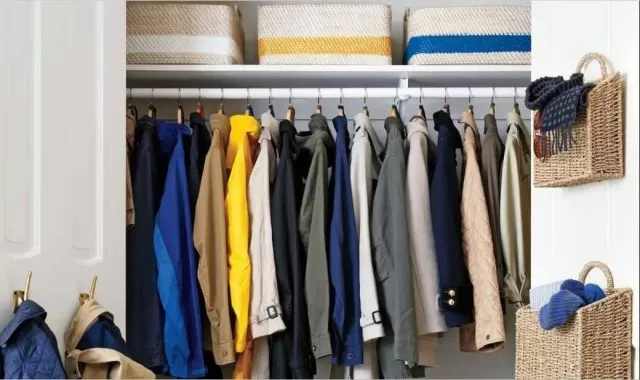
If you don’t require an over-the-door organizer for shoes, repurpose it for accessories! Most rolled-up scarves and winter beanies fit nicely into individual slots meant for shoes.
The same goes for umbrellas, bottles of sunscreen, lint rollers, sunglasses, and pairs of gloves. For larger accessories such as outdoor toys or bulky kids’ items, cubby drawers offer an easy way to stay organized without creating visual clutter.
Consider these efficient storage options for accessories in a coat closet:
Stackable, open-front bins on a shelf:
Closets often have ample height, allowing you to stack two or three storage bins.
Place out-of-season accessories in the bottom bins and swap them as needed. If stacking bins isn’t ideal, consider adding an extra shelf.
Slide a folding step stool into the closet to reach items comfortably.
Hanging sweater cubby:
If there’s space on the rod, hang one of these organizers and consider using drawer inserts to prevent items from falling out.

Standing drawer unit:
This works well if you have both floor and vertical space available.
Measure carefully before purchasing to ensure it fits. Assign and label one drawer per family member to store their belongings.
Hooks:
Everyday bags, totes, and backpacks can hang on S hooks on the rod, a rack on the back of the door, or individual hooks on the inside wall.
Consider a hanging scarf or hat organizer as well.
Customizable door rack:
Baskets and pegboards with hooks can hold a variety of items, from accessories to pet supplies.
Wall-mounted file folders:
If you use the coat closet to store mail and memos, attach vertical organizers with labels to the inside of the door.
Remember to go through the contents weekly, if not daily.
*The information is for reference only.